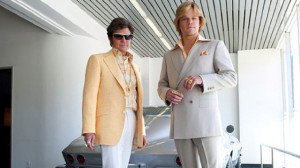Private Lives – Theatre
The play Private Lives has more lives than a cat. Written by Noel Coward in the 1920s, it had its debut at London’s Phoenix Theatre in 1930 to rave reviews, and starred Coward and Laurence Olivier. The next year it opened on Broadway. 83 years later, Private Lives is still making the rounds, now at The Gielgud Theatre, and again, it is a hit.
The story is a very simple one. Newlyweds Elyot and Sibyl (Toby Stephens and Anna-Louse Plowman) are on a hotel balcony in Deauville talking about their future together, and discussing Elyot’s previous marriage. In the room next door to them are Amanda and Victor (Anna Chancellor and Anthony Calf), also newlyweds enjoying one of their first nights together. Separating both couples on the balcony is a small partition, and wouldn’t you know it: Elyot and Amanda used to be married, and in a very volatile relationship.
After arguing with their respective partners over very minor matters, Amanda spots Elyot on his balcony. Coy, shy and nervous at first, Amanda speaks to Elyot and not too long later, jumps over the partition to be with him. They share a drink, reminisce about their marriage, have a few laughs, and before you know it, they decide in a ‘will they or won’t they’ moment, to run off together to Paris where Amanda has a flat that her new husband knows nothing about.
Once in the flat, they act like honeymooners all over again, loving and laughing, and then arguing and fighting, just as they did when they were previously married. Finally, they have their biggest fight and things could not get any worse, and in walk Amanda and Victor. The fighting between Elyot and Amanda continues, and also ensues between Elyot and Sibyl and Victor and Amanda. Who is going to end up with whom? You have to wait until the end to find out.
Considering that Private Lives has played in the West End several times in the past 13 years (most recently at the Vaudeville Theatre in 2010 with Kim Cattrall and Matthew Macfadyen), this version of the play, a transfer from the Chichester, has opened to rave reviews and will be talked about for years to come.
Chancellor upstages everyone in the cast; she can tell a joke, pout when needed, give out a big laugh when necessary, and dance and flail her arms memorably. Her chemistry with Stephens is very palpable, very real, that it makes it believable that she could fall in love with him all over again. Her eyes flutter, her gowns (and robe) drape over her like she is a star, and a star she is. Stephens is able, somewhat, to keep up with her, firstly as the man whose second wife is seven years younger than him, to believably falling back in love with his ex-wife, smouldering in one moment and then vile the next. Calf and Plowman are second fiddles to the main two actors. They are able enough, but this is Chancellor’s show, and they know it.
The set design, by Anthony Ward, is luscious. The balcony in the first act is gorgeous, but when the play switches to the Paris flat, we see exactly what we expect: a flat decorated in French style, from the checkerboard floor to the paintings on the wall, very detailed and lovely to look at. The script is funny, witty, dramatic; all you could ask for in a Noel Coward play.
Given the fact that everyone who watches this play has a great time, it should be no surprise Private Lives is still going strong, some 70 years after it began.






